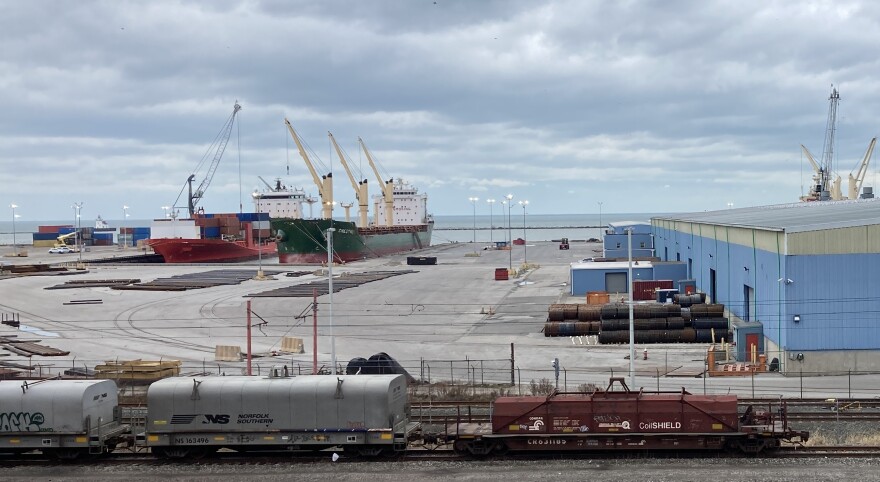The Port of Cleveland board of directors unanimously approved its 2024-2028 strategic plan, along with its first climate action plan, Thursday in an effort to expand the city’s shipping economy and advance sustainable practices.
The Port of Cleveland is the first port in the Great Lakes Region to adopt a climate action plan; its goal is to achieve net zero greenhouse gas emissions by 2050. The goal aligns with reduction targets set by the city of Cleveland, the Northeast Ohio Areawide Coordinating Agency and the Biden administration.
“We're out in front and leading in terms of how do we decarbonize our port, how do we get to a point where we can run everything off electricity, not off of fossil fuels, and do our part not only for climate change, but also lessen impacts on our neighbors as well,” Port of Cleveland President and CEO Will Friedman said.
Our strategic plan, which we update every five years, is really a set of policies, goals, actions and then measurements that are the direction from the board to the staff in terms of what we're going to implement, what we're going to try to get done for the port over the next five years.Will Friedman, The Port of Cleveland President and CEO
The port’s biggest goal will be to “electrify everything we can control by 2050,” Friedman said. This will primarily include Port of Cleveland’s own equipment, which he said should be the most achievable, and where the port is getting its power.
“We're working with Cleveland Public Power right now to potentially maybe use solar energy on the rooftops of our buildings down at the port as one source of energy,” Friedman said, “and then maybe use what are called power purchase agreements through CPP to buy renewable energy so we're not sourcing from coal burning plants or plants that are not renewable.”
The third focus area includes business partners like trucking and cargo ship companies and is the largest carbon emitter in the port contributing to about 80% of emissions according to Senior Manager of Planning, Environment and Information Systems Carly Beck.
“We have committed ourselves to working directly with our terminal operator Logistec to provide whatever they need for charging infrastructure, for example, to reduce their … emissions.”
The port began tracking its air quality impacts in 2016, according to the news release, which includes calculations of pollution emitted from equipment, vehicles and vessels.
While the Port of Cleveland cannot directly control its business partners, it plans to provide incentives, like charging stations, grant funding and rebate programs, to encourage carbon emission reduction.
The port may look into implementing mandates in the future to meet emission reduction goals depending on the market, Friedman said.
“We can't go out and give a mandate to a customer and then they go to another port that would ... sort of be self-defeating,” he said. “So, we're going to try to balance all that out and drive toward our overall goal of carbon neutrality by 2050.”
Though Cleveland’s manufacturing history might create different perspectives on the relationship between manufacturing and sustainability, it is possible to do both, Board Chair J. Stefan Holmes said.
“The port has been traditionally a leader not only in in economic development but also in bringing about ecological understanding and bringing it to a really a forefront for the entire community on how important it is to have our lake and river clean,” he said. “Commerce as well as the environmental considerations go hand in hand and you can do both. You can be leaders in both, and so I'm just pleased that we've come to recognize that fact.”
The decision to implement a climate action plan largely came from a push from Port of Cleveland customers, Friedman said.
“If we were to say, 'oh no, we're not going to take this seriously,' I've already heard from some of our major customers who have said there would be a big problem for us,” he said. “Our board, as you can see, voted unanimously. We're moving ahead and we're excited to get this work done.”
The approval of the climate action plan will also allow the Port of Cleveland to compete for federal Congestion Mitigation & Air Quality Improvements grant funding to support its Advanced Cargo Processing & Fiber Connectivity Project and the Reduction of Truck Emissions at Port Facilities grant program, the news release stated.
In addition to the climate action plan, the strategic plan also includes new opportunities for shipping Ohio’s agriculture and manufactured products to Europe and expand its diversity, equity and inclusion efforts.
“How do we, how do people get to a point where they're qualified, where they have the right credentials, where they sort of checked all the boxes and they can come in and compete successfully for business?” Friedman said. “We have to do some work on our part to help them … get ready in that in that arena."
The port will provide historically disadvantaged businesses with resources and guidance, while continue its community investments in its Community Impact Fund to support additional workforce development programs, according to the news release.






